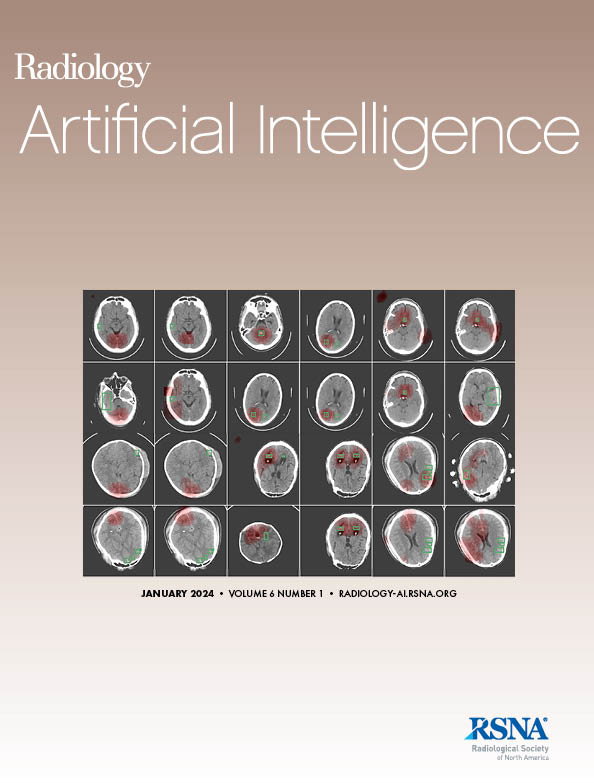Harim Kim, Kyungsu Kim, Seong Je Oh, Sungjoo Lee, Jung Han Woo, Jong Hee Kim, Yoon Ki Cha, Kyunga Kim, Myung Jin Chung
下载PDF
{"title":"人工智能辅助分析,帮助检测胸片上的肱骨病变。","authors":"Harim Kim, Kyungsu Kim, Seong Je Oh, Sungjoo Lee, Jung Han Woo, Jong Hee Kim, Yoon Ki Cha, Kyunga Kim, Myung Jin Chung","doi":"10.1148/ryai.230094","DOIUrl":null,"url":null,"abstract":"<p><p>Purpose To develop an artificial intelligence (AI) system for humeral tumor detection on chest radiographs (CRs) and evaluate the impact on reader performance. Materials and Methods In this retrospective study, 14 709 CRs (January 2000 to December 2021) were collected from 13 468 patients, including CT-proven normal (<i>n</i> = 13 116) and humeral tumor (<i>n</i> = 1593) cases. The data were divided into training and test groups. A novel training method called <i>false-positive activation area reduction</i> (FPAR) was introduced to enhance the diagnostic performance by focusing on the humeral region. The AI program and 10 radiologists were assessed using holdout test set 1, wherein the radiologists were tested twice (with and without AI test results). The performance of the AI system was evaluated using holdout test set 2, comprising 10 497 normal images. Receiver operating characteristic analyses were conducted for evaluating model performance. Results FPAR application in the AI program improved its performance compared with a conventional model based on the area under the receiver operating characteristic curve (0.87 vs 0.82, <i>P</i> = .04). The proposed AI system also demonstrated improved tumor localization accuracy (80% vs 57%, <i>P</i> < .001). In holdout test set 2, the proposed AI system exhibited a false-positive rate of 2%. AI assistance improved the radiologists' sensitivity, specificity, and accuracy by 8.9%, 1.2%, and 3.5%, respectively (<i>P</i> < .05 for all). Conclusion The proposed AI tool incorporating FPAR improved humeral tumor detection on CRs and reduced false-positive results in tumor visualization. It may serve as a supportive diagnostic tool to alert radiologists about humeral abnormalities. <b>Keywords:</b> Artificial Intelligence, Conventional Radiography, Humerus, Machine Learning, Shoulder, Tumor <i>Supplemental material is available for this article.</i> © RSNA, 2024.</p>","PeriodicalId":29787,"journal":{"name":"Radiology-Artificial Intelligence","volume":" ","pages":"e230094"},"PeriodicalIF":8.1000,"publicationDate":"2024-05-01","publicationTypes":"Journal Article","fieldsOfStudy":null,"isOpenAccess":false,"openAccessPdf":"https://www.ncbi.nlm.nih.gov/pmc/articles/PMC11140509/pdf/","citationCount":"0","resultStr":"{\"title\":\"AI-assisted Analysis to Facilitate Detection of Humeral Lesions on Chest Radiographs.\",\"authors\":\"Harim Kim, Kyungsu Kim, Seong Je Oh, Sungjoo Lee, Jung Han Woo, Jong Hee Kim, Yoon Ki Cha, Kyunga Kim, Myung Jin Chung\",\"doi\":\"10.1148/ryai.230094\",\"DOIUrl\":null,\"url\":null,\"abstract\":\"<p><p>Purpose To develop an artificial intelligence (AI) system for humeral tumor detection on chest radiographs (CRs) and evaluate the impact on reader performance. Materials and Methods In this retrospective study, 14 709 CRs (January 2000 to December 2021) were collected from 13 468 patients, including CT-proven normal (<i>n</i> = 13 116) and humeral tumor (<i>n</i> = 1593) cases. The data were divided into training and test groups. A novel training method called <i>false-positive activation area reduction</i> (FPAR) was introduced to enhance the diagnostic performance by focusing on the humeral region. The AI program and 10 radiologists were assessed using holdout test set 1, wherein the radiologists were tested twice (with and without AI test results). The performance of the AI system was evaluated using holdout test set 2, comprising 10 497 normal images. Receiver operating characteristic analyses were conducted for evaluating model performance. Results FPAR application in the AI program improved its performance compared with a conventional model based on the area under the receiver operating characteristic curve (0.87 vs 0.82, <i>P</i> = .04). The proposed AI system also demonstrated improved tumor localization accuracy (80% vs 57%, <i>P</i> < .001). In holdout test set 2, the proposed AI system exhibited a false-positive rate of 2%. AI assistance improved the radiologists' sensitivity, specificity, and accuracy by 8.9%, 1.2%, and 3.5%, respectively (<i>P</i> < .05 for all). Conclusion The proposed AI tool incorporating FPAR improved humeral tumor detection on CRs and reduced false-positive results in tumor visualization. It may serve as a supportive diagnostic tool to alert radiologists about humeral abnormalities. <b>Keywords:</b> Artificial Intelligence, Conventional Radiography, Humerus, Machine Learning, Shoulder, Tumor <i>Supplemental material is available for this article.</i> © RSNA, 2024.</p>\",\"PeriodicalId\":29787,\"journal\":{\"name\":\"Radiology-Artificial Intelligence\",\"volume\":\" \",\"pages\":\"e230094\"},\"PeriodicalIF\":8.1000,\"publicationDate\":\"2024-05-01\",\"publicationTypes\":\"Journal Article\",\"fieldsOfStudy\":null,\"isOpenAccess\":false,\"openAccessPdf\":\"https://www.ncbi.nlm.nih.gov/pmc/articles/PMC11140509/pdf/\",\"citationCount\":\"0\",\"resultStr\":null,\"platform\":\"Semanticscholar\",\"paperid\":null,\"PeriodicalName\":\"Radiology-Artificial Intelligence\",\"FirstCategoryId\":\"1085\",\"ListUrlMain\":\"https://doi.org/10.1148/ryai.230094\",\"RegionNum\":0,\"RegionCategory\":null,\"ArticlePicture\":[],\"TitleCN\":null,\"AbstractTextCN\":null,\"PMCID\":null,\"EPubDate\":\"\",\"PubModel\":\"\",\"JCR\":\"Q1\",\"JCRName\":\"COMPUTER SCIENCE, ARTIFICIAL INTELLIGENCE\",\"Score\":null,\"Total\":0}","platform":"Semanticscholar","paperid":null,"PeriodicalName":"Radiology-Artificial Intelligence","FirstCategoryId":"1085","ListUrlMain":"https://doi.org/10.1148/ryai.230094","RegionNum":0,"RegionCategory":null,"ArticlePicture":[],"TitleCN":null,"AbstractTextCN":null,"PMCID":null,"EPubDate":"","PubModel":"","JCR":"Q1","JCRName":"COMPUTER SCIENCE, ARTIFICIAL INTELLIGENCE","Score":null,"Total":0}
引用次数: 0
引用
批量引用

 求助内容:
求助内容: 应助结果提醒方式:
应助结果提醒方式:


